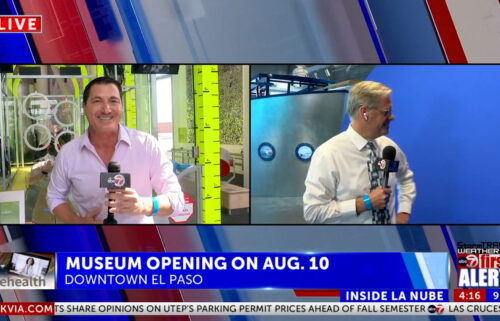Researchers working to reverse ‘alarming’ veteran suicide trends
Click here for updates on this story
EDMOND, Oklahoma (Tulsa World) — University of Central Oklahoma researchers are trying to better understand Oklahoma’s “alarming” veteran suicide metrics while developing new strategies to reverse long-term trends.
Oklahoma’s veteran suicide rate in 2018 is 10th highest in the nation, according to the latest data available from the U.S. Department of Veterans Affairs. On average, 112 veterans in Oklahoma have died by suicide each year since 2005.
Mark Kinders is a Marine Corps veteran and retired UCO administrator who has been granted visiting scholar status to coordinate the university’s experts work with external partners as part of the Governor’s Challenge to address veteran suicide.
After 15 months of work, Kinders described the state’s situation as “alarming.”
He said a ratio used by researchers and the VA to measure suicide ideation among veterans suggests that between 20,000 to 54,000 of Oklahoma’s 290,000 veterans are experiencing some form of mental distress, while more than 800 have thoughts of suicide.
“I have a certain level of frustration that it takes as long as it does to be able to have the kind of intervention that we would like to have,” Kinders said. “There’s an awful lot of people who are invested in trying to mitigate veteran suicide in Oklahoma.
“But it really comes down to this is an extraordinarily complex issue of a limited amount of resources — fiscal resources, people resources. The causality — the etiology — of veteran suicide in Oklahoma as well as nationally is very troubling trying to get your hands around it in the most effective way.”
Gov. Kevin Stitt in 2019 appointed a work group after accepting the Governor’s Challenge from the U.S. Substance Abuse and Mental Health Services Administration to build a collaborative effort to identify gaps in services.
Kinders said Oklahoma’s response is based on the VA’s national strategic plan, which has 14 goals and 43 objectives to reduce veteran suicide. The VA is challenging states and providers to dramatically ramp up investment in mitigation strategies with a target to cut veteran suicides 20% by 2025.
There is plenty of research about what has been tried and doesn’t work, he said, but what is effective is connecting veterans to others.
“Ideating veterans need safety nets,” Kinders said. “They have to have support networks of family members or civic or fraternal organizations, religious groups, higher education, veteran services offices — places where they can turn to where they can connect with people and be able to turn to individuals who care and will help them out.”
Kinders said the spectrum of reasons contributing to veteran suicide aren’t known but existing literature indicates more than a dozen factors might play a role. Some are apparent like post-traumatic stress syndrome or traumatic brain injuries.
In Oklahoma, he said, UCO researchers have found that the type of occupations veterans have is a clear factor.
The top three jobs in order for veterans in Oklahoma who die by suicide are truck driver, mechanic and welder.
The common link? Work that primarily is in isolation, Kinders said. Those same positions in the general population rank Nos. 4-6 in terms of death by suicide, he said.
“Veterans are clearly gravitating to something to where they might already have experience in the military and it should be a warning to employers that they need to ensure that they have the safety net in place for their veterans who are in those occupations,” Kinders said.
UCO research also has found that Vietnam-era veterans in Oklahoma die by suicide at twice the rate of national trends. Kinders said there isn’t an explanation for why, but the university is collaborating with Michael Hudson, retired from the Marine Corps, and his risk management platform company to scrape more data to glean better insight.
Data in Oklahoma in general isn’t as good as it could be.
For example, Kinders said, the state Medical Examiner’s Office doesn’t distinguish between veterans or civilians when ruling a death a suicide. He said the Oklahoma State Department of Health collects that data but isn’t consistent in gathering causal factors.
Kinders said he was connected with Hudson through U.S. Sen. Jim Inhofe’s office.
Hudson, vice president of ClearForce, said organizations make it easy for veterans to reach out — but that isn’t enough.
With better data in a secure environment, he said, groups can potentially identify triggers early to be proactive in offering tailored help and resources.
“Why does the veteran always have to ask for help? Why do they have to knock on our door?” Hudson said. “That’s our goal, how do we flip the model and change it so we reach out to the veteran. We want to reach out to the veteran in a way to empower them, not fix them.”
UCO has submitted a pilot project proposal for a $450,000 grant from the National Institute of Mental Health to develop an app with a predictive algorithm to engage with veterans contemplating suicide.
Kinders said veterans in crisis will be directly connected to their counselors or safety nets via smartphones or smartwatches. Veterans can regularly report how they feel and an action plan they devise themselves will kick in if they are experiencing mental distress or begin to ideate suicide.
“How am I feeling today on a risk factor, say, of one to five,” Kinders said. “If it starts getting into a range where it’s worrisome, the program will come back to them automatically and say, ‘Why don’t you go take the dog for a walk?’ — which is what that veteran identified they are going to do if they are ideating.”
The Oklahoma Department of Veterans Affairs already has implemented several efforts stemming from the Governor’s Challenge.
Aaron Ashworth, the agency’s mental health and suicide prevention programs administrator, said Mayor’s Challenges in Tulsa, Oklahoma City and Lawton have established a corridor of collaboration along Interstate 44.
As for rural settings, Ashworth said ODVA is working with Oklahoma State University’s Project ECHO program to start training and educating providers of best practices and treatment for veterans.
There also is a three-tiered communication and education campaign involving veterans, their families, community stakeholders and mental health and health care providers.
Ashworth said his one of his favorite efforts is “OK Valor” on ODVA’s website at oklahoma.gov/veterans.
He said OK Valor is a geographic information system in which veterans — or anyone — can research whatever social service they might want or need based on location or radius from home. Those needs could include child care, housing, food, bill assistance, health care or mental health care.
Ashworth said a main gap the Governor’s and Mayor’s Challenges uncovered is a lack of awareness of resources, so OK Valor is that answer as a one-stop shop.
“What’s important if we’re going to save people from suicide and suicidal ideations is making sure those life protective factors are taken care of,” Ashworth said.
Please note: This content carries a strict local market embargo. If you share the same market as the contributor of this article, you may not use it on any platform.




